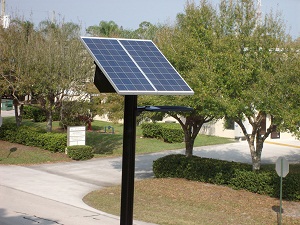Sol lighting brings off-grid affordable solution to commercial lighting
 It used to be that solar-powered commercial lights only made economic sense in the third world. Not anymore.
It used to be that solar-powered commercial lights only made economic sense in the third world. Not anymore.
“Today, in most cases, they don’t cost any more to install than typical lighting,” said Sol president Paul Wickberg. “Now, it’s such an obvious choice.”
Sol has been building solar commercial lighting for many years, but since the product reached grid parity with standard commercial lighting systems about a year ago, the company has been growing rapidly.
Sol installs parking lot, pathway and roadside lighting.
The Sol lighting systems mount solar panels and LEDs atop poles in the ground without connecting them to the grid. While the components cost more than standard lighting equipment, the cost saved on wiring and electrical engineering make Sol cost competitive.
While the system costs about the same to install, it costs nothing to run. There are no electric bills associated with this commercial lighting system, Wickberg said.
The solar panels charge battery packs on the light poles that hold a single day’s charge for up to five days, which means there’s virtually no risk of the lights running out of self-sustaining power, Wickberg said.
Up until this month, Sol has focused most of its efforts in developing countries in places like Africa where the electric infrastructure just wasn’t there to support standard commercial lighting options. And business is still good in those markets, Wickberg said.
In the United States, Sol’s technology can be spotted on military bases and out in remote state and national parks and on forest lands where it would have cost a lot to bring the electrical infrastructure out to support lighting.
The systems themselves are highly programmable and attractive.
“This is the same quality lighting a major retailer would find attractive,” Wickberg said.
But retailers weren’t interested. Before this year, the technology and the quality of LEDs along with the prices of solar panels kept major retailers from signing up.
It’s a different story now, Wickberg said. He has contracts to install systems for two major retailers in new locations this year, which he suspects might be the beginning of a trend.



